Keiryu Fishing
“Keiryu” is the Japanese word for "mountain stream." Keiryu fishing, then,
is mountain stream fishing in Japan. In the broadest sense, "keiryu fishing" encompasses several popular fishing methods in Japan, including lure fishing, fly fishing, tenkara and bait fishing. The term "keiryu rods," though, is generally understood to mean the bait fishing rods, and on TenkaraBum.com, the term "keiryu" and "keiryu fishing" will be used to reference fishing with the Japanese bait fishing rods in the manner they are used in Japan, whether the angler uses live bait or an artificial fly.
Like tenkara, keiryu fishing utilizes a long rod with the line tied to the rod
tip. Unlike tenkara, though, keiryu is primarily a method for fishing with live
bait - often a mayfly nymph or caddis larva that anglers collect from under
rocks on the stream they are fishing. In the US, there seems to be a general
sense that bait fishing is something you grow out of - kind of like going
barefoot. Almost everyone starts that way but almost no one stays that way.
Most move on to spinning gear, some move on to fly rods, and some move on to baitcasters.
Among trout fishermen in the US, particularly among trout fishermen who fish
mountain streams, fly fishing is considerably more popular than bait fishing.
Not so in Japan. Keiryu is probably ten times more popular than tenkara.
In the US, tenkara is still much more popular than keiryu, but keiryu fishing is growing.
The Rods
Just as tenkara rods have evolved to be very well suited to fishing unweighted
wet flies on small mountain streams, keiryu rods have evolved to be very well
suited for fishing with weight on the line and for fishing larger streams.
Perhaps the biggest difference between keiryu fishing with live nymphs and tenkara fishing
with sakasa kebari is keiryu's use of split shot. Unweighted tenkara flies are generally fished in the top few inches of the water column. With the benefit of split shot, keiryu baits are fished in the bottom few inches.
To be able to handle casting the weight, and also getting good hook sets when
fishing deep, most keiryu rods tend to be stiffer than tenkara rods.
However, there is a very wide variety of keiryu rods, ranging from the very stiff to the very soft. With respect to action and stiffness, there is no clear dividing line between keiryu rods and tenkara rods, and the softest keiryu rods are
very nearly as soft as the softest tenkara rods.
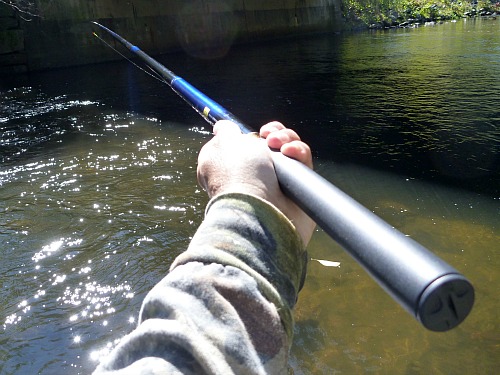
Keiryu rods tend to be much more tip flex than tenkara rods. The stiffer mid and butt sections provide the firmness required to get good hook sets when fishing deeper in the water column. The flexible tip sections allow the fish to take the bait without feeling much resistance on the line. Trout will spit out live bait if they feel resistance from a stiff rod tip!
Keiryu rods also come in a much wider range of lengths. In Japan, tenkara rods
are pretty generally from 3 to 4.5 meters in length (roughly 10' to 14.5').
Keiryu rods, on the other hand, run from perhaps 2.4
meters
(under 8') to as much as
8 meters (over 26'). "Honryu" (main stream) rods are still for bait fishing but are too long for
most mountain streams, at 8 - 10 meters (up to 33 feet!).
I think it is very important to note, though, that many - perhaps even most - keiryu rods will cast a tenkara line beautifully! And perhaps surprisingly, the longer rods seem to cast better than the shorter ones. They have more inertia, and it is largely inertia that loads the rod when you are using a very light line. I have now fished with a number of 5.4m and 6.3m rods and all but one cast a size 3 tenkara line beautifully. The very long "Honryu" keiryu rods intended for larger rivers have so much inertia, though, that casting a tenkara line becomes difficult. For dual use rods, I would say that 6.3m is the sweet spot.
If you want a rod specifically for keiryu fishing rather than a dual use rod for keiryu and tenkara, I have to say that longer is better. After fishing with a 6.3m rod, a 5.4m rod just feels too short and it definitely feels like you are fishing too close to where you are standing. In keiryu fishing, with less casting and longer drifts than tenkara fishing, the inertia you feel when casting is less important. Fishing far enough away that your presence does not scare the fish is always important. I have caught a lot of fish with 5.4m rods. However, if the stream is wide enough to use a 6.3 or 6.4m rod I will definitely choose the longer rod.
The Lines
In tenkara, as in fly fishing, the angler casts the weight of the line. The
essentially weightless fly goes along for the ride. In keiryu, on the other
hand, since split shot is used to get the bait deep, the angler can cast the
weight of the shot. Not only can the line then be pretty light, lighter is
actually better. The lighter the line, the less it is subject to wind resistance when
casting; the less it limits the free and natural drift of the bait. More
important, though, the less it sags from its own weight.
Compared to fly fishing, tenkara fishing is a tight line method. Much is
written on these pages about the advantages of keeping your line off the
water's surface. Tenkara anglers find that hard to do unless they
use a light level line. Compared to
keiryu lines, though even a tenkara line is extremely heavy and sags
noticeably.
In contrast to fly lines, or even tenkara lines, keiryu lines are extremely light. You could make the entire line from tippet material. For keiryu fishing, the lighter the better (until you get to the point where fish are routinely breaking off). A lighter line will give you a more natural drift an will result in more hook ups.
Some of the newer keiryu rod models, like the Suntech Aoi ZPRO, FMX Keiryu ZPRO and the softest PROSPEC RC rods, can handle lines that are about 1# breaking strength. It is the ultimate in ultralight fishing!
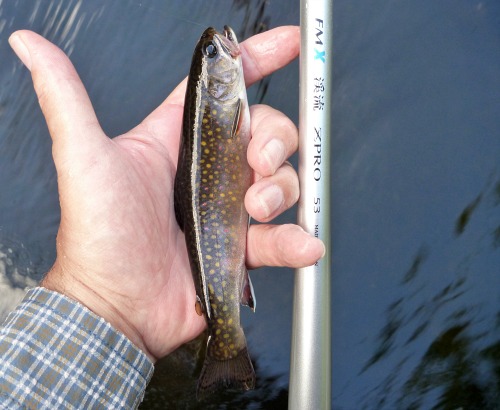 Rated for lines as light as 1lb test!
Rated for lines as light as 1lb test!Because the line is almost weightless and the weight of the split shot is
holding it tight, keiryu anglers are able to fish with a line that is virtually
straight from the rod tip to the split shot. The split shot is attached to the
line perhaps 8" or so above the hook. There can be a little slack between
the shot and the hook, but very little. Anglers who utilize a hybrid of tenkara
and keiryu, fishing weighted artificial nymphs rather than a split shot and a live
nymph can eliminate even that little bit of slack, fishing a tight line
from the rod tip all the way to the fly.
Keiryu anglers also fish with a shorter line (relative to rod length) than the
vast majority of tenkara anglers, with the line length from rod tip to hook
generally no more than the length of the rod and often a bit less.
Two of my best days were with a 4.4m rod and a line (including tippet) two feet shorter than the rod, and with a 6.3m rod and a line (including tippet) four feet shorter than the rod. That's shorter than most Japanese keiryu anglers use, but Oh My, what great drifts!
With a tight line from rod tip to hook, combined with a very long rod, keiryu
anglers can fish with their line entering the water almost vertically. Drag is
essentially nonexistent and cross currents are very nearly irrelevant. That is a huge advantage!
The Markers
There is one disadvantage to fishing with a line as light as keiryu anglers use. You can't see it. The rods, despite their length, are quite sensitive, though, and many takes will be felt. However, as with tenkara, if you wait until you feel the take, in many cases you will have waited too long. With an artificial fly, if you wait too long the fish will spit out the fly. With live bait, if you wait too long the fish will swallow the hook.
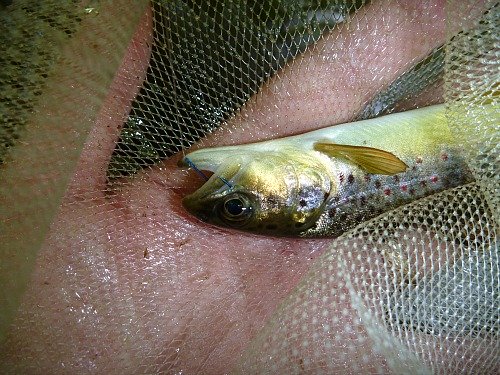
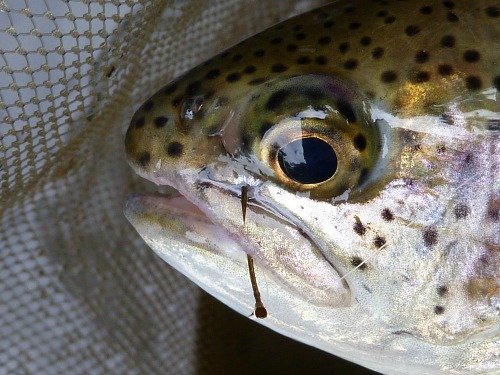 |
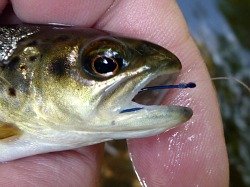 |
Despite the common belief that bait fishing causes substantially higher fish
mortality than fly fishing, that does not seem to be the case with keiryu
fishing. As a kid just starting out fishing with bait, I was taught to wait a bit before striking, to "make sure he's got it." That is referred to as passive bait fishing and it allows the fish time to swallow the bait. The resulting deep hooking clearly does increase the chances of fish mortality.
Keiryu uses an active bait fishing approach rather than a passive approach. With an active bait fishing approach, one sets the hook at the first indication of a strike, just as in fly fishing. My own experience, and that of John Vetterli of the Tenkara Guides in Salt Lake City, is that virtually all the fish caught are hooked just where you would hook them if you were fishing with flies. With no deep hooking there is no greater mortality.
I have noticed, though, that trout are much quicker to swallow a salmon egg than a worm. Even strikng at the first hint of a take occasionally was too late. Once I realized that, I stopped fishing with salmon eggs.
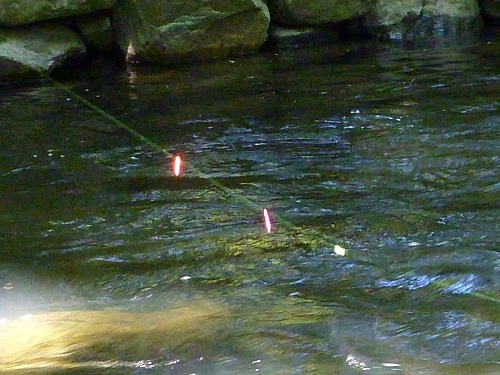
In order to set the hook quickly, at the first indication of a strike, you need a very sensitive method of strike detection. Spin fishermen use a short rod and long line, much of which is under the surface and because of different current speeds, is not perfectly straight from rod tip to hook. Keiryu anglers use a much longer rod and relatively short line that is nearly vertical, with little line actually in the water. They use what are called "markers" on their line, fixed so they are just above the water's surface.
There is very little slack between the hook and the markers, so they are extremely sensitive to the slightest movement of the hook. Seeing the markers dip or even just hesitate is a much more sensitive indicator of a fish taking your bait than feeling for a strike when spin fishing. You will know that a fish has taken your bait before it has a chance to swallow it. You can react instantly, and the long rod magnifies the slightest move of your hands so your hook sets can be extremely quick. Thus, keiryu fishing isn't just active bait fishing, it's hyperactive bait fishing!
There are two main types of
markers. One is a series of little plastic flags that are attached to the line. The
other type is a series of short pieces of brightly colored polypropylene yarn tied around
the line. After having tried both, I prefer the yarn markers. The plastic flag markers weigh more and cause noticeable line sag.
In the US, yarn indicators are commonly used in what is called "indicator nymphing." There is a big difference, though, between a fly fisherman's yarn "indicator" and a keiryu angler's yarn "marker." The purpose of the markers is not to suspend the nymph, so they can be much smaller. Being smaller, they are less affected by wind resistance when casting than a large indicator would be.
Keiryu anglers
will use two to four markers at a time, attached to the line so that the lowest one will still be
above the water's surface. With three or four on the line, spaced a few inches apart, you can easily see the angle change if your bait hesitates at all, whether because your bait hits a rock or a fish hits your bait. Finally, since the markers are just a few small knots on the line above the surface instead of large foreign object floating
down the stream, they are much less likely to scare highly pressured trout. (I have had atlantic salmon parr and warpaint shiners leap out of the water in an attempt to eat the markers, so I seriously doubt they scare fish.
The Bait
In Japan, keiryu anglers will often gather mayfly nymphs and caddis larvae from underneath rocks on the stream they are fishing. This is the ultimate in "matching the hatch." It is not legal in New York state, however. Please check the regulations where you fish before doing it.
In addition to nymphs and larvae taken from the stream, Japanese anglers also use earthworms, meal worms, salmon eggs and what they call bee moth larvae (which we call wax worms).
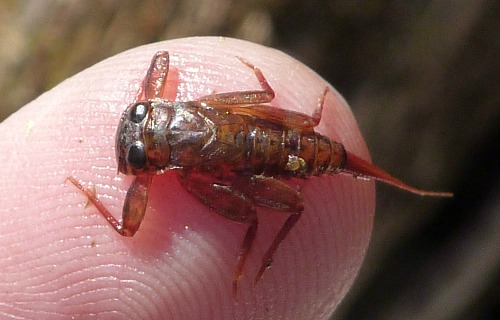 Mayfly Nymph Mayfly Nymph |
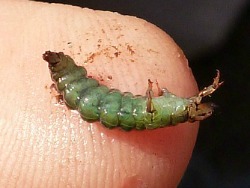 Caddis Larva Caddis Larva |
In the US, most
keiryu anglers use artificial nymphs
rather than live bait. The use of artificials is too deeply ingrained in
our
fishing culture – particularly among stream fishermen. Even with artificials, I would expect them to be extremely
successful. Personally, I'm more interested in the fishing method
than with whether the hook holds a real nymph or an artificial one, an
earthworm or a San Juan worm. (Fly fishing purists will claim a San Juan
worm isn't really a fly. I bet keiryu purists would claim it
isn't really a worm.)
Keiryu fishing with bait is catching on in the US, though. It think to some extent, anglers in the US have been shamed into using only artificials. As they realize that there are people they know who fish with worms and are not at all ashamed to admit it, and as they learn that keiryu fishing with bait is not incompatible with catch-and-release, more people are trying it - and having great success.
My personal favorite bait is the Red Wiggler. Trout take them readily, and it seems they are slower to swallow a worm than they are a salmon egg, which results in a much lower incidence of deep hooking. Worms stay on the hook much better than salmon eggs. Worms are also easy to raise yourself - so after you buy worms once you should never have to buy them again!
A couple experienced worm "ranchers" have contributed articles on how to raise them. Tony Schollmeier has written a page on how to choose Composting Worms for fishing.
If you want to fish with bait but don't want to mess with worms, you should consider the Eurotackle Mummy Worms, which are preserved wax worms. If for some reason you don't go fishing much, they will last for six months without refrigeration and up to two years with refrigeration (and no, they don't turn into moths). They also don't make your hands stink, like Powerbait does. Plus, they work really well.
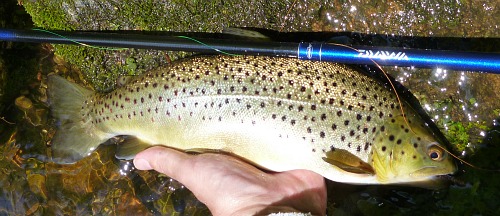 Daiwa Kiyose 30SF
Daiwa Kiyose 30SFFollowing my introduction of the Daiwa Kiyose 30SF to US anglers in the spring of 2011, lots of tenkara anglers have experienced the benefits that one of the stiffer keiryu rods can provide for fishing heavily weighted nymphs. Increasingly, tenkara anglers are also learning the benefits of using one of the longer keiryu rods for fishing not only nymphs but also wet flies and even dries.
One of my best days ever was when I first used a 4.5 meter rod on a small
stream. Despite the overhead branches and the tree-lined banks, using the extra
long rod with an extra short line I got drifts I'd never gotten before. I caught
lots of fish on both wet flies and dry flies! On a larger stream or river, the same result can be
obtained with a 5.4 or 6.3 meter rod and a commensurately short line. I recently had my best day on particular a stream by using a 6.3m rod and fishing Killer Bugs with a relatively short line.
If you feel as I do that the main advantage of tenkara is improved presentation
rather than simplicity, you will probably also agree that the improved
presentation and drag-free drifts really are pretty much limited to relatively
small streams. You can certainly use tenkara rods on larger rivers, but if you
want the same drag free drifts, you will have fish at the same close range in a large river that you do
in a small stream. To get the same great drifts further away you will need a longer rod. (I subsequently learned that the goal of using a longer line with a tenkara rod on a larger stream is not achieving a dead drift anyway, but rather fly manipulation that A) induces strikes, and B) keeps the line tight and off the water's surface.)
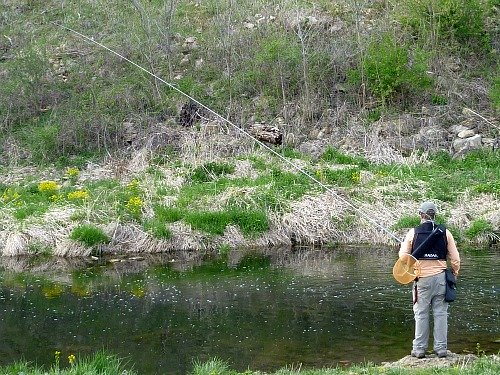 Keiryu angler with 7m rod.
Keiryu angler with 7m rod.People in the US are only starting to fish with the longer keiryu rods but I suspect more and more people will discover the benefits of fishing with a longer rod rather than just a longer line. Keeping the line off the surface is just as important on a larger river as it is on a smaller stream. Whether the two handed 5.4 and 6.3 meter keiryu rods are used with light tenkara lines or with keiryu lines and markers, and whether they are used with split shot and live nymphs, weighted artificial nymphs, unweighted wets or even dries, I think the benefits are real and will be realized.
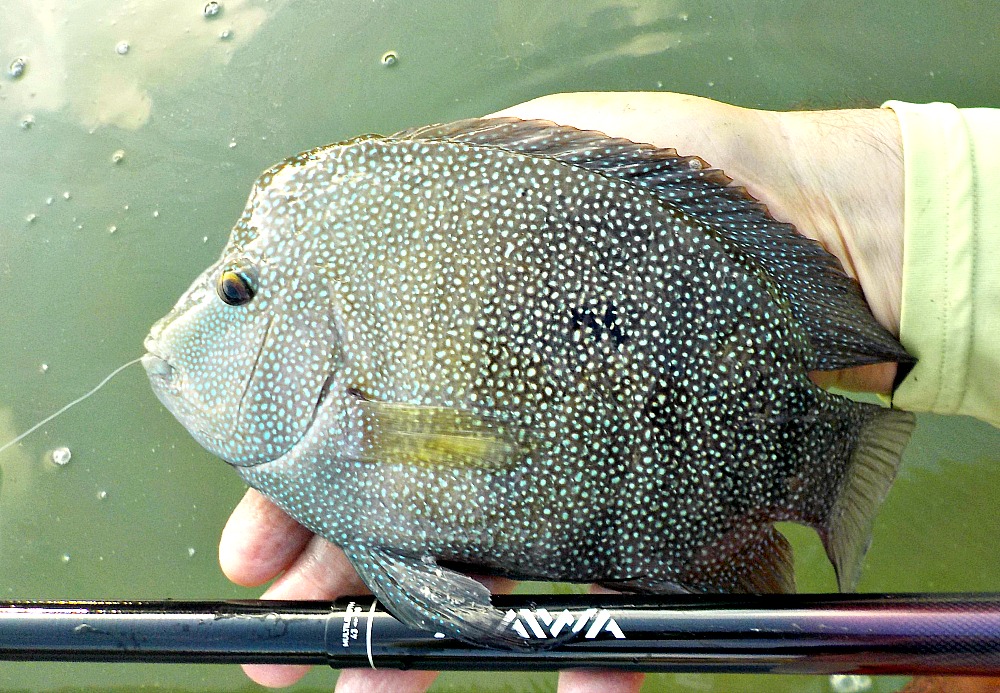 John E photo
John E photoAnd don't think for a minute that keiru fishing is only for trout. This cichlid took a nightcrawler. A lot of fun with a Daiwa Kiyose 43M!
TenkaraBum Home > Keiryu Fishing
“The bitterness of poor quality remains long after the sweetness of low price is forgotten” - Benjamin Franklin
"Be sure in casting, that your fly fall first into the water, for if the line fall first, it scares or frightens the fish..." -
Col. Robert Venables 1662
As age slows my pace, I will become more like the heron.
We've all had situations where seriously chewed up flies kept catching fish after fish after fish. It is no sin to tie flies that come off the vise looking seriously chewed up.
Warning:
The hooks are sharp.
The coffee's hot.
The fish are slippery when wet.
Beware of the Dogma
What's in stock?
Suntech Tenkarakyo 40F Tenkara Rods
Daiwa Keiryu-X 39
Nissin Oni Tenkara Line
Coming Soon
December
Kurenai II AR 30F
Kurenai II AR 33F
Kurenai II AR 39F
Nissin Oni Line size 3
Nissin Oni Line size 3.5
TenkaraBum 33
TenkaraBum 36
TenkaraBum 40
Medium Rod Case
January
Furaibo TF39
Furaibo TF39TA
Latest Pages
Related Items
I have been fishing Tenkara for 4 years. I only fish lakes and creeks and only used unweighted flies. During the past 4 years I have caught lots of fish. Tenkara is wonderful but with so many trees and people around casting has always been a problem!
One day I read your introduction to Keiryu. So I thought why not try it.
All I can say is Keiryu is much more practical for fishing lakes and creeks from shore. I can now present my flies in any spot that a spin caster can fish. I am catching more fish, more adult fish and more species than with tenkara. I just wanted to thank you for introducing Keiryu.
Michael M, New Jersey
Thank you for writing about keiryu style fishing. I like to catch a lot of fish when I go fishing. You have me so intrigued with it, I have order a red wiggler farm so I can raise my own worms. I am 63 years young and I see myself returning to the fishing of my youth.
I am coming full circle, but with much more understanding of fishing. I feel like a kid again thanks to tenkara and keiryu fishing. So, I just want to let you know that I support you 110% in what you are doing. So please continue to ignore the purists.
Thanks for returning my excitement for fishing again.
Les A, Idaho
I have been fishing some wax worms on this rod. That is a ton of fun. I think Keiryu fishing is about the most fun method for trout.
Thank you again for your help, I am a VERY satisfied customer.
F.J. P, Pennsylvania
If you enjoy spin fishing or baitcasting please visit my sister site Finesse-Fishing.com.
I recently had my first attempt at actual Keiryu fishing (albeit with a bead head rather than bait), and immediately saw the effectiveness.
A deep slow pool that has given me fits in the past became rather simple with my Fine Power 66. Those yarn markers work great and the sensitivity of those rods to feel every tap is amazing.
Kris F, Montana


